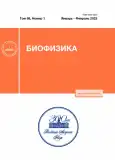Frequency and time domain characteristics of the insect visual system in optic flow
- Authors: Zienko S.I1, Zhbanova V.L1
-
Affiliations:
- Branch of National Research University "Moscow Power Engineering Institute" in Smolensk
- Issue: Vol 68, No 1 (2023)
- Pages: 98-107
- Section: Articles
- URL: https://journals.rcsi.science/0006-3029/article/view/144408
- DOI: https://doi.org/10.31857/S0006302923010106
- EDN: https://elibrary.ru/OAIXWK
- ID: 144408
Cite item
Full Text
Abstract
About the authors
S. I Zienko
Branch of National Research University "Moscow Power Engineering Institute" in Smolensk
Email: stanislav-zienko@rambler.ru
Smolensk, Russia
V. L Zhbanova
Branch of National Research University "Moscow Power Engineering Institute" in Smolensk
Email: vera-zhbanova@eandex.ru
Smolensk, Russia
References
- В. П. Тыщенко, Физиология насекомых (Высшая школа, М., 1986).
- M. J. Klowden, Physiological Systems in Insects. Academ. Press, 2007. 688 p.
- Nation J. L. Insect Physiology and Biochemistry, 2nd Edition (CRC Press, 2008).
- B.-M. Song and Ch.-H. Lee, Front Neural Circuits, 12, 16 (2018). doi: 10.3389/fncir.2018.00016
- В. Г. Беспалов, С. А. Козлов, А. Н. Петров и др. Фемтосекундная оптика и фемтотехнология (Университет ИТМО, СПб., 2018).
- Ю. А. Шполянский, Автореф. дисс. … докт. физ-мат. наук (Университет ИТМО, СПб., 2010).
- С. И. Зиенко и В. Л. Жбанова, Прикладная физика, № 3, 46 (2021). doi: 10.51368/1996-0948-2021-3-39-46
- S. I. Zienko and V. L. Zhbanova, Scientific and Technical Journal of Information Technologies, Mechanics and Optics, 21 (6), 828 (2021). doi: 10.17586/2226-1494-2021-21-6-828-836
- О. П. Исакова, Ю. Ю. Тарасевич и Ю. И. Юзюк, Обработка и визуализация данных физических экспериментов с помощью пакета Origin (Книжный дом "Либриком", М., 2009).
- О. В. Лазоренко и Л. Ф. Черногор, Радиофизика и радиоастрономия, 13 (2), 166 (2008).
- Ultra-wideband Radar Technology, Ed. by D. James and P. E. Taylor (CRC Press, Boca Raton, 2000).
- Э. В. Семенов, Автореф. дисс. … докт. техн. наук (М., 2012).
- А. В. Коваленко, С. М. Вовк и Е. Г. Плахтий, Журн. прикладной спектроскопии, 88 (2), 297 (2021).
- Я. Б. Зельдович и А. Л. Мышкис, Элементы прикладной математики (Наука, М., 1972).
- S. I. Zienko and D. S. Slabkovsky, Technical Physics Letters, 45 (46), 537 (2019).
- S. I. Zienko and D. S. Slabkovsky, Optics and Spectroscopy, 127 (3), 564 (2019).
- С. И. Зиенко и Д. С. Слабковский, Прикладная физика, № 1, 36 (2020).
- М. П. Туманов, Теория линейных систем автоматического управления: Учебное пособие (МГИЭМ, М., 2005).
- И. С. Гоноровский, Радиотехнические цепи и сигналы (Радио и связь, М., 1986).
- В. В. Пасынков и В. С. Сорокин, Материалы электронной техники, 3-е изд. (Издательство "Лань", СПб.: 2001).
Supplementary files










